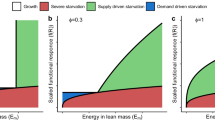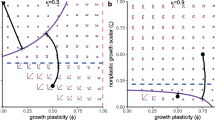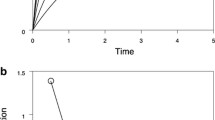Abstract
The physiological-structured population models assume that a fixed fraction of energy intake is utilized for individual growth and maintenance while the remaining for adult fertility. The assumption results in two concerns: energy loss for juveniles and a reproduction dilemma for adults. The dilemma results from the possibility that adults have to breed even if metabolic costs fail to be covered. We consider a size-structured population model, where standard metabolism is given top priority for utilizing energy intake and the surplus energy, if there is any, is distributed to individual growth and reproduction. Moreover, the portion of surplus energy for reproduction is size-dependent and increases monotonically with size. Using the newly developed parameter continuation, we demonstrate their disparate effects on population dynamics. Results show that the size-dependent mechanism of energy allocation primarily exerts destabilizing effects on the system but considerably promotes species coexistence, in comparison with the size-independent mechanism. We conclude that the size-dependent mechanism is, to a large extent, a dispensable component of model ingredients when ontogeny is explicitly taken into consideration.
Similar content being viewed by others
References
Andersen, K. H., & Beyer, J. E. (2006). Asymptotic size determines species abundance in marine size spectrum. Am. Nat., 168, 54–61.
Andersen, K. H., & Pedersen, M. (2010). Damped trophic cascades driven by fishing in model marine ecosystems. Proc. R. Soc. B, 277, 795–802.
Claessen, D., & de Roos, A. M. (2003). Bistability in a size-structured population model of cannibalistic fish—a continuation study. Theor. Popul. Biol., 64, 49–65.
Cushing, J. M. (1992). A size-structured model for cannibalism. Theor. Popul. Biol., 42(3), 347–361.
de Roos, A. M., Metz, J. A. J., Evers, E., & Leipoldt, A. (1990). A size-dependent predator prey interaction: Who pursues whom? J. Math. Biol., 28, 609–643.
de Roos, A. M., & Persson, L. (2001). Physiological structured models—from versatile technique to ecological theory. Oikos, 94, 51–71.
de Roos, A. M. (2008). Demographic analysis of continuous-time life-history models. Ecol. Lett., 11, 1–15.
de Roos, A. M., Diekmann, O., Getto, P., & Kirkilionis, M. A. (2010). Numerical equilibrium analysis for structured consumer resource models. Bull. Math. Biol., 72, 259–297.
Diekmann, O., Gyllenberg, M., Metz, J. A. J., Nakaoka, S., & de Roos, A. M. (2010). Daphnia revisited: local stability and bifurcation theory for physiologically structured population models explained by way of an example. J. Math. Biol., 61, 277–318.
Gallardo, C. S., Manque, C., & Filum, M. (2004). Comparative resistance to starvation among early juveniles of some marine muricoidean snails. Nautilus, 118, 121–126.
Hartvig, M., Andersen, K. H., & Beyer, J. E. (2011). Food web framework for size-structured populations. J. Theor. Biol., 272(1), 113–122.
Kooijman, S. A. L. M. (2000). Dynamic energy and mass budgets in biological systems. New York: Cambridge University Press.
Kirk, K. L. (1997). Life-history responses to variable environments: starvation and reproduction in planktonic rotifers. Ecology, 78, 434–441.
Kirkilionis, M. A., Diekmann, O., Lisser, B., Nool, M., Sommeijer, B. P., & de Roos, A. M. (2001). Numerical continuation of equilibria of physiologically structured population models. I. Theory. Math. Models Methods Appl. Sci., 11(6), 1101–1127.
Kuznetsov, Y. A. (1994). Elements of Applied Bifurcation Theory. New York: Springer.
Lester, N. P., Shutter, B. J., & Abrams, P. A. (2004). Integrating the von Bertalanffy model of somatic growth in fishes: the cost of reproduction. Proc. R. Soc. B, 271, 1625–1631.
Nisbet, R. M., McCauley, E., Gurney, W. S. C., Murdoch, W. W., & Wood, S. N. (2004). Formulating and testing a partially specified dynamic energy budget model. Ecology, 85, 3132–3139.
Nisbet, R. M., McCauley, E., & Johnson, L. R. (2010). Dynamic energy budget theory and population ecology: lessons from Daphnia. Philos. Trans. R. Soc. B, 365, 3541–3552.
Sousa, T., Domingos, T., Poggiale, J. C., & Kooijman, S. A. L. M. (2010). Dynamics energy budget theory restores coherence in biology. Philos. Trans. R. Soc. B, 365, 3413–3428.
West, G. B., Brown, J. H., & Enquist, B. J. (2001). A general model for ontogenetic growth. Nature, 413, 628–631.
Weitz, J. S., & Levin, S. A. (2006). Size and scaling of predator-prey dynamics. Ecol. Lett., 9, 548–557.
Author information
Authors and Affiliations
Corresponding author
Rights and permissions
About this article
Cite this article
Zhang, L., Lin, Z. & Pedersen, M. Effects of Growth Curve Plasticity on Size-Structured Population Dynamics. Bull Math Biol 74, 327–345 (2012). https://doi.org/10.1007/s11538-011-9675-z
Received:
Accepted:
Published:
Issue Date:
DOI: https://doi.org/10.1007/s11538-011-9675-z




